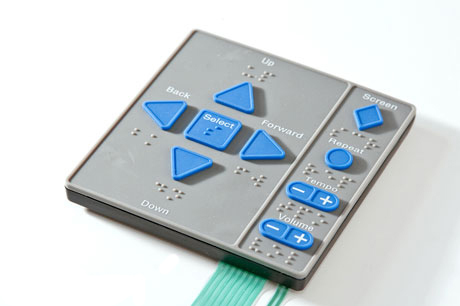Comprehending Membrane Layer Switches Over: The Key to Trusted and resilient Controls

What Are Membrane Layer Buttons?
Membrane switches are a sophisticated solution in the world of interface innovation, integrating capability and design flawlessly. These gadgets work as an interface between individuals and digital systems, incorporating numerous parts into a small format. Commonly created from adaptable, slim layers of products, membrane switches are designed to react to touch, allowing customers to engage with equipment and electronic devices effectively.
The key elements of a membrane switch consist of a published circuit layer, visuals overlay, and a spacer layer that protects against unintentional activation. The graphic overlay can be customized to reflect brand name identification or individual choices, enhancing appearances while making sure use. Membrane buttons are commonly utilized in various applications, consisting of clinical tools, customer electronic devices, and industrial tools, owing to their longevity and resistance to ecological aspects such as moisture and dust.
One of the vital advantages of membrane layer switches is their capability to stand up to damage, making them excellent for high-traffic settings. In addition, they are light-weight and need marginal room, permitting cutting-edge layouts in item development. Generally, membrane layer changes stand for a functional and reliable selection for modern electronic interfaces, marrying technology with user-centric style concepts.
Exactly How Membrane Switches Work
The operation of membrane layer changes rest on a simple yet reliable system that translates user input into electronic signals. These buttons contain several layers, typically including a graphic overlay, a spacer layer, and a circuit layer. When a customer presses the switch, the leading layer flaws, enabling a conductive component in the circuit layer to reach an equivalent conductive pad on the bottom of the visuals overlay. This contact shuts the circuit and sends out a digital signal to the tool, suggesting that the switch has been turned on.
The layout of membrane layer switches can vary, yet they usually integrate domes or tactile components to supply feedback to the customer, enhancing the overall experience - membrane switch. The materials utilized in membrane buttons, such as polyester or polycarbonate, contribute to their sturdiness and resistance to environmental elements, including dampness and dust. The published circuits are normally enveloped, which secures them from wear and tear over time.
Advantages of Membrane Switches

In addition, membrane layer switches are understood for their sturdiness. Constructed from robust products, they are resistant to dirt, dampness, and physical wear, which dramatically prolongs their life-span contrasted to traditional mechanical switches. This longevity makes them specifically appropriate for high-traffic atmospheres and applications calling for long life.
One more substantial advantage is the simplicity of cleaning and upkeep. The smooth surface of membrane layer switches reduces dust buildup and is often unsusceptible spills, making them suitable for setups that need frequent sanitization.
Additionally, membrane buttons website link use a structured account, bring about a thinner design that can be integrated into different devices without including mass. This feature not only boosts the aesthetic appeal but additionally adds to a more ergonomic product layout.
Applications of Membrane Layer Switches
Functional and user-friendly, membrane layer buttons locate applications across a large range of sectors, including medical tools, consumer electronic devices, and industrial tools. In the clinical field, these buttons are integral to tools such as analysis devices, person tracking systems, and mixture pumps, where reliability and ease of cleansing are important. Their capacity to withstand severe settings and preserve functionality makes them excellent for such applications.

In consumer electronics, membrane layer switches are used in products like microwaves, cleaning makers, and push-button controls - membrane switch. Their streamlined design allows for instinctive interface, boosting the overall customer experience while supplying toughness and resistance to tear and put on
Industrial equipment also gains from membrane layer switches, especially in control panels for equipment and automation systems. These switches use defense versus dust and wetness, making sure consistent performance in challenging atmospheres. Moreover, their adjustable functions enable manufacturers to customize them to particular operational needs, improving performance and capability.
Picking the Right Membrane Switch
When choosing a membrane layer button, it is vital to consider numerous elements that influence efficiency and viability for details applications. The key considerations consist of environmental problems, responsive comments, longevity, and design specifications.
First, assess the operating setting; buttons subjected to wetness, chemicals, or severe temperature levels require particular products to ensure longevity and capability. Next off, examine the need for tactile responses. Depending on individual communication, some applications may take advantage of a tactile feedback to validate activation, while others might like a non-tactile layout for aesthetic reasons.
Resilience is another crucial variable; membrane buttons need to be made to hold up against constant usage, impacts, and abrasion. Make sure the selected button can withstand the expected lifecycle, especially in high-usage circumstances.

Verdict
To conclude, membrane switches over act as necessary elements in the layout of sturdy and trustworthy control systems throughout numerous industries. Their small design, integrated with durable construction and customizable functions, enhances user communication while making sure durability popular environments. The adaptability of membrane switches over permits customized options that satisfy particular functional requirements, enhancing their significance in modern-day innovation. As industries proceed to evolve, the value of incorporating effective membrane button services can not be click to read more overemphasized.
Membrane switches over stand for a crucial facet of modern interface layout, blending capability with resilience why not try these out in different applications.Membrane layer switches are a sophisticated service in the world of user interface modern technology, integrating performance and style perfectly. Typically created from adaptable, slim layers of materials, membrane layer buttons are designed to respond to touch, enabling users to connect with equipment and electronic gadgets efficiently.
The layout of membrane buttons can vary, however they usually include domes or responsive elements to offer comments to the individual, improving the overall experience.In conclusion, membrane changes serve as important components in the layout of resilient and trusted control systems throughout numerous industries.